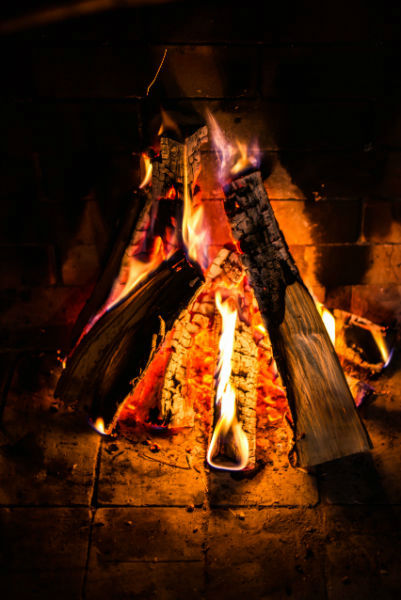Wood-burning fireplace chimneys smell smoky whether they’ve just been swept or not, because no matter how thoroughly the flue is swept, every trace of soot and soaked-in creosote cannot possibly be removed. Even if every microscopic remnant of wood smoke deposits were sandblasted out of the flue, the very first wood fire would deposit a fresh layer, and the nasty smoky smell would return. Truth is, not every fireplace makes a house smell bad.
So the real question isn’t why your fireplace smells smoky. The question is: “Why is the smell coming into your house?”
 No matter how tightly you house is constructed, there are many, many openings to the outside. They are mostly there by design. Think about it. There are kitchen & bathroom exhaust fans, clothes dryers, and fireplace flues, just to name a few. Then there are those that are just there by default, such as electrical, plumbing, cable and ductwork penetrations, leaky windows and doors, etc. At any given moment in time, air is coming and going from your house in and out of those “holes”.
No matter how tightly you house is constructed, there are many, many openings to the outside. They are mostly there by design. Think about it. There are kitchen & bathroom exhaust fans, clothes dryers, and fireplace flues, just to name a few. Then there are those that are just there by default, such as electrical, plumbing, cable and ductwork penetrations, leaky windows and doors, etc. At any given moment in time, air is coming and going from your house in and out of those “holes”.
The biggest of these “holes” to the outside, in most houses, is the fireplace chimney. Even though a fireplace chimney can allow airflow in both directions, when it is in use, it is a powerful force sending air OUT of the house. The chimney updraft created by an open fireplace fire can move more air than the other “holes” combined can supply! This is why you don’t usually smell the campfire smell when a fire is burning in the fireplace. It is usually when the fire dies down, and the updraft slows down to the point where air going out from other places overcomes it, that the airflow in the fireplace flue reverses and the smell comes back into the house.
So what are the other places where air is going out of the house, causing makeup air to be pulled in through the fireplace chimney?
- It could be an unbalanced central heating and air conditioning system, kitchen or bathroom exhaust fan or clothes dryer.
- It could be the wind. It happens when the wind blows against the house and creates positive pressure on the windward side and negative pressure on the leeward side.
- It could be rising exhaust gases in woodstove, furnace or water heater flues.
- It could be “stack effect“. Heated air has lower density than cold air, so the warm, buoyant air in your house wants to rise through the roof, while the cold, heavy air in your unused fireplace chimney wants to flow downward into the house. If there are “holes” in the upper stories or roof to allow the rising room air to escape, the warm air will flow up and out of the house and replacement air will flow down the chimney and in through the fireplace. This is more pronounced in taller, leakier houses and in houses with cold chimneys (like chimneys on outside walls, with their entire length exposed to outdoor temperature).
- It could be rainy weather. Rainy weather accelerates the stack effect, because the wet air entering the chimney is heavier than the dry air in the house.
Whatever the cause, whenever air travels to the outside of the house, an equivalent amount of air attempts to enter SOMEWHERE to replace it. If the chimney offers the path of least resistance for the makeup airflow, the smoky smell of wood creosote will enter the house along with the replacement air through that biggest of “holes” the chimney.
What can you do to stop your house from using the fireplace chimney for makeup air?
You need to make it harder for the air to flow back down the chimney than to come through the other “holes” allowing air to enter the house. Here are some ideas:
- Try closing the fireplace damper when not in use. This might do the job. However most fireplace dampers are pretty leaky, so this alone might not do the trick.
- You might add a good, tight-fitting glass door/fire screen. While this might solve the problem, it will also lessen the flow of heated air OUT of the fireplace and into your house, when you have a fire.
- Think about a top-sealing damper.These are installed at the top of a masonry chimney, and are opened and closed via a stainless steel cable running down the inside of the flue.
- Provide a source of outside combustion air to your furnace, woodstove and water heater so they are not siphoning air out of the house. This will reduce the demand for replacement air.
Blue Sky Chimney Sweeps|Bless Your Hearth can help diagnose your house pressure issue.

